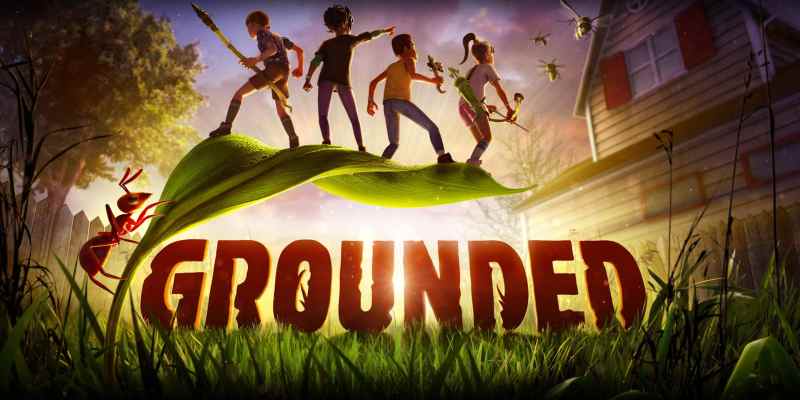What we’ve got with Obsidian Entertainment’s Grounded, the developer’s first Xbox title since being acquired by Microsoft, is something we never expected: a famous CRPG developer deciding to make Honey, I Shrunk the Kids as a cooperative survival game full of action-packed hunting.
It’s understandable that some might’ve worried about Obsidian reaching so far outside of its wheelhouse, which is why I’m glad to say that Obsidian’s legitimately on to something with its pint-sized survival experience. It turns out being a micro-kid in a backyard is a ton of fun, if you can avoid being eaten.
During my time with the demo, Grounded used towering objects above the grass as natural points of interest and lost objects like books and baseballs as memorable landmarks. Blades of grass dwarf you, but that also means that chopping them down can make natural bridges in addition to building supplies. The whimsical tone allows for cute bugs that more resemble mice and dogs — but watch out for predators, like a spider. Combined with a naturalistic approach to crafting gear and structures to camp in, Grounded knits together elegantly. It really harnesses every aspect of its premise to the fullest.
I was given the task in the demo of reactivating a growth pad to grow my shrunken kid back to human size. In order to do so, I had to figure out why two of the arrays that power the transformation weren’t working. One was blocked, while the other was flickering on and off. With this objective, Grounded effectively explained all its core systems.
The blocked laser was only kept at bay by a blade of grass, but cutting that blade of grass required using a miniaturized scanning tool to unlock a new crafting recipe, which then let me craft a hand axe. In unlocking this crucial tool, I also unlocked the ability to craft walls and other parts of structures, in addition to learning how to manipulate the environment for easier navigation. It even opened the door for crafting torches, which I’d soon need once I approached the other tower.
Ant holes and spider dens dot the landscape, every insect interacting dynamically. Most, at a glance, aren’t interested in picking a fight with you. Somehow even aphids of all things are cute, but you learn quickly which ones to hunt and which to play nice and cautious with. Ladybugs are gigantic tanks, and ants won’t need a second smack to warrant their chasing you. While several require aggravation before getting hostile, others are less polite. For instance, mites were chewing the other laser tower’s cable to pieces.
At this juncture, combat and platforming take center stage as you climb up the cable and then delve deep into a dark cave to swat away every mite saboteur. If you don’t have a torch upon entering, not all hope is lost, as charging headlong in reveals a natural bioluminescent plant you can wield instead. You also have to deal with some plant growth on the cable, either leaping over it or cutting it away to reach the top. Both solutions in each situation flow organically from how much you know and the approach you want to take. Forgive the pun, but Grounded is marvelously organic in this way, keeping a steady drip feed of new challenges and surprises the longer one explores.

That all said, there is one thing I’m less than keen on, and that’s limiting certain crafting recipes to the scanner I mentioned earlier. You have to wait on a timer to scan more materials. This is made all the more tedious by the fact the structure containing the scanner is incredibly small and easy to lose track of when exploring. Certain crafting items that are crucial to getting started were also spread a bit too far away from the player, often requiring blind exploration.
On their own, these design decisions would be fine, but together they make for an unnatural obstacle to progress. Why do I need a computer to tell me that a fibrous plant can be turned into rope yet can instantly intuit how to make a spear? These oddities didn’t prevent me from having fun, but they are something Obsidian should bear in mind when ironing out Grounded’s progression curve.
Grounded’s biggest surprise by far though is how satisfying its combat is. You can throw almost any weapon for a stunning attack, with little trouble recollecting your weapons thereafter. Weapon degradation is more than reasonable, letting you get a fair use out of your armaments and tools. Virtually every piece of equipment pulls double duty, serving some means besides simply badgering local insects to pieces. There’s enough tactical variety that you’ll want to alternate between crafted gear and simpler options like pebbles. Whether playing in either third- or first-person, you have a good lay of the land, with a sizable field of vision to keep you from getting ambushed, as well as a clear alert prompt.

Lastly, like Gears 5 and Bleeding Edge, Grounded has excellent accessibility features. They use non-standard colors for the user interface, clear-to-read subtitles, an arachnophobia mode that transforms spiders into white blobs for those who’d prefer to be rid of them, and everything from text-to-speech for in-game text to full control re-bindings. And when I say full re-bindings, I mean you can set the same key to multiple different functions without the game giving you any hassle. It’s great to see, and with how well-balanced the game already feels, hopefully this game is a worthwhile option for those looking for a more accessible gaming experience.
I’m not sure I’d say Grounded is a full AAA experience. It’s close to it, almost a “AA and a half” sort of game, but I don’t say that as a mark against it. In a genre full of Minecraft rip-offs and asset flips, Grounded is more than a cut above the competition. I look forward to when it enters Xbox Preview on July 28 on Xbox and Xbox Game Pass and Steam Early Access.
